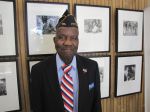(Part one of a series)
Since the founding of this nation, men and women have had to continue to fight for the rights proclaimed on Independence Day. Over the past century, millions of African-Americans have served in the armed forces to protect America’s freedom.
For some, the environment was one where racial discrimination ran rampant. Still, many others found the military as a place where color lines were blurred and brotherhoods were forged with men from different races and cultures.
 |
| LIVING LEGEND—Henry Parham is one of the few remaining members of the 320th Battalion for Anti-Aircraft Barrage Balloons. |
For World War II veteran Henry Parham discrimination in the military was no worse than the everyday discrimination he experienced in his hometown of Greenville, Va. After being drafted in 1942 he joined the all-Black 320th Battalion for Anti-Aircraft Barrage Balloons.
“I don’t think we were treated any differently. We were a unit and we always stuck together as a unit,” said Parham, 88. ”We were considered a special unit and that’s why we were a little more protected.”
Parham arrived on Omaha Beach on June 6, 1944, the day many now know as D-Day as part of the only all-Black unit in the landings. While Americans have become familiar with the horrific images of this day through movies and documentaries, Parham witnessed it firsthand.
“It wasn’t anything so hard so much as just being in dangerous situations. You’re scared for your life everyday,” said Parham. “We were waiting for our time to land and when we looked through the glass it was horrible. When we finally landed there were 15,000 on the beach. You had to watch where you walked.”
Parham’s five-man crew was in charge of protecting Omaha Beach. They used barrage balloons to destroy German planes and to protect the American landing craft responsible for bringing reinforcements and supplies to the beach.
The barrage balloons were filled with helium and attached to steel cables, restricting the airspace available to enemy aircrafts and channeling their flights into zones protected by ground-based artillery. The cables while also hazardous to pilots were connected to TNT that would explode when the wing of the plane slid to the top of the cable.
“The camps there weren’t very equipped. At one point we didn’t even have heat or hot water. We stayed on the beach 68 days. We had to sleep in the ground,” Parham said. “So our program was to protect the beach and the equipment and we were very successful.”
After leaving the beach Parham went on to Sherburne, France where he helped protect the legendary General George Patton’s army. He later went on to Georgia where he trained to serve in the South Pacific. Fortunately the war ended two days after he was scheduled to ship out.
“The boat we were in broke down at sea because it was one of the boats injured in Pearl Harbor,” said Parham. “I came back in perfectly good health.”
Upon returning home, Parham went on to study as a television technician and a tailor. He was able to take advantage of the G.I. Bill that provided college or vocational education for returning WWII veterans, which many Blacks were denied.
“In those days, Blacks weren’t recognized very much for anything. Blacks weren’t allowed to vote. They were drafted into the army but they couldn’t vote,” said Parham. “When times get tough they call on us.”
Parham is a long time volunteer at the Highland Drive Veterans Hospital and he also works with the New Pittsburgh Courier. He also spends time working for the American Legion and received the commemorative medal for the 50th Anniversary of D-Day.